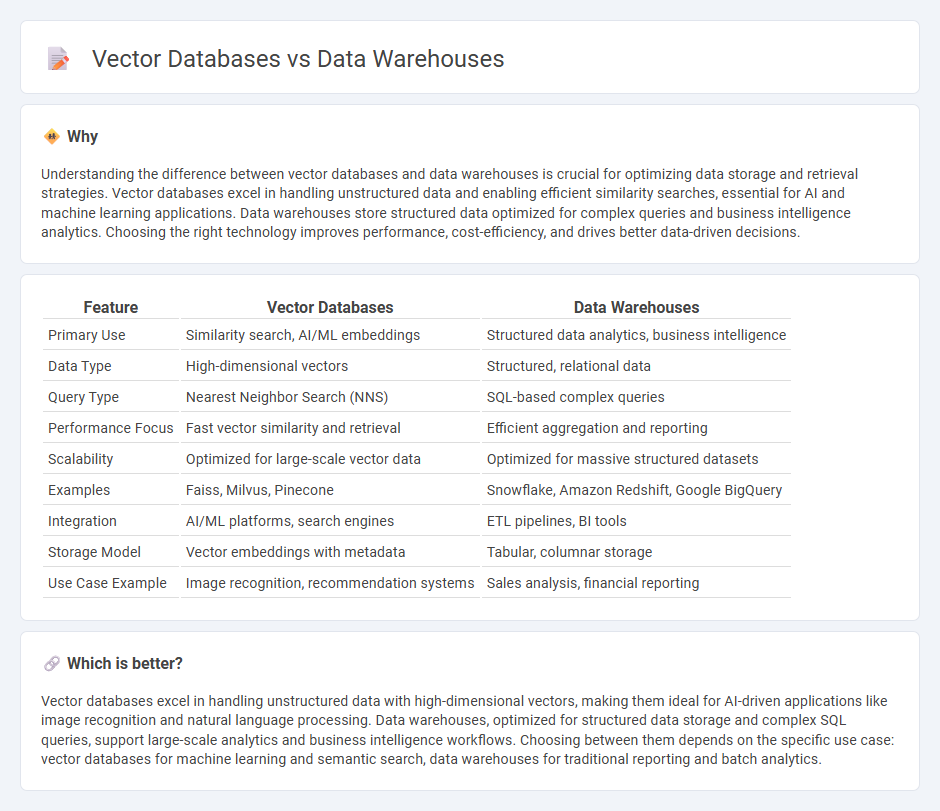
Vector databases excel at managing high-dimensional data for applications like machine learning and AI, offering faster similarity searches and scalable indexing. Data warehouses specialize in storing and analyzing structured, transactional data with strong support for complex queries and reporting. Explore the key differences and use cases to understand which solution fits your technological needs better.
Why it is important
Understanding the difference between vector databases and data warehouses is crucial for optimizing data storage and retrieval strategies. Vector databases excel in handling unstructured data and enabling efficient similarity searches, essential for AI and machine learning applications. Data warehouses store structured data optimized for complex queries and business intelligence analytics. Choosing the right technology improves performance, cost-efficiency, and drives better data-driven decisions.
Comparison Table
| Feature | Vector Databases | Data Warehouses |
|---|---|---|
| Primary Use | Similarity search, AI/ML embeddings | Structured data analytics, business intelligence |
| Data Type | High-dimensional vectors | Structured, relational data |
| Query Type | Nearest Neighbor Search (NNS) | SQL-based complex queries |
| Performance Focus | Fast vector similarity and retrieval | Efficient aggregation and reporting |
| Scalability | Optimized for large-scale vector data | Optimized for massive structured datasets |
| Examples | Faiss, Milvus, Pinecone | Snowflake, Amazon Redshift, Google BigQuery |
| Integration | AI/ML platforms, search engines | ETL pipelines, BI tools |
| Storage Model | Vector embeddings with metadata | Tabular, columnar storage |
| Use Case Example | Image recognition, recommendation systems | Sales analysis, financial reporting |
Which is better?
Vector databases excel in handling unstructured data with high-dimensional vectors, making them ideal for AI-driven applications like image recognition and natural language processing. Data warehouses, optimized for structured data storage and complex SQL queries, support large-scale analytics and business intelligence workflows. Choosing between them depends on the specific use case: vector databases for machine learning and semantic search, data warehouses for traditional reporting and batch analytics.
Connection
Vector databases enable efficient storage and retrieval of high-dimensional data such as embeddings used in AI and machine learning applications, while data warehouses aggregate structured data for large-scale analytics and reporting. The connection lies in their complementary roles where vector databases handle unstructured or semi-structured data formats, and data warehouses manage structured, relational datasets to provide comprehensive insights. Integrating vector databases with data warehouses enhances the ability to perform advanced analytics by combining similarity search capabilities with traditional query processing on extensive business datasets.
Key Terms
Structured Data (Data Warehouses)
Data warehouses excel at handling structured data by organizing vast amounts of information into predefined schemas, enabling complex queries and analytics for business intelligence. They support SQL-based querying and are optimized for aggregating, reporting, and historical data analysis, making them essential for enterprises focused on transactional data insights. Explore how structured data management with data warehouses can enhance your data strategy.
Embeddings (Vector Databases)
Data warehouses store structured data optimized for query performance and analytics, while vector databases specialize in managing high-dimensional embeddings for similarity search and machine learning applications. Embeddings in vector databases enable efficient processing of unstructured data such as images, text, and audio by representing them as dense vectors within a multi-dimensional space. Explore the advantages and use cases of vector databases to understand their critical role in AI and advanced data analysis.
Query Optimization
Data warehouses optimize query performance through structured schemas, indexing, and parallel processing to handle large-scale analytical workloads. Vector databases enhance query optimization by leveraging similarity search algorithms and high-dimensional indexing techniques designed for unstructured data like images or text embeddings. Explore our detailed comparison to understand how these technologies impact efficient data retrieval.
Source and External Links
What is a Data Warehouse? - AWS - A data warehouse is a central repository that stores data from various sources for analysis to support informed decision-making.
What is a Data Warehouse? | IBM - A data warehouse aggregates data from multiple sources into a single, consistent store to support analytics and business intelligence.
What Is a Data Warehouse? - Oracle - A data warehouse is a data management system designed for business intelligence activities, centralizing data from multiple sources to aid in decision-making.
 dowidth.com
dowidth.com